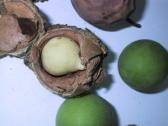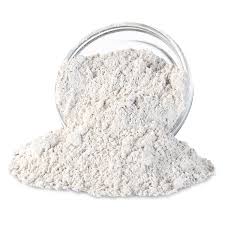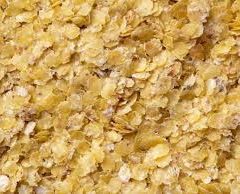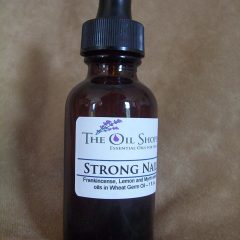Foraha oil, (Tamanu), Madagascar - Not refined is green, dark, and milky. It has an under appreciated vegetable scent although its other properties provide its appeal. Foraha is luxuriant and moist. It smooths and softens the skin without leaving a residue because it readily absorbs. It makes an exceptional carrier oil.
The botanical name Calophyllum Inophyllum is derived from the Greek, Kalos meaning beautiful and Phullon meaning leaf. It is also know as Indian Laurel, Alexandrian Laurel and Tamanu. In Samoa it is called Fetau, and Penaga Laut in Malaysia. Hawaiians call it Kamani or Kamanu. In Madagascar of course, it is Foraha.
Scientist have taken special interest in Foraha. Studies done in 1998 at University of Sherbrooke in Canada analyzed Foraha and determined coumarin in the oil contained two compounds, calanolide A and calanolide B which other studies concluded were useful against HIV.
Trying to inhibit the Epstein-Barr virus scientists in Japan studied several 4-phenylcoumarins taken from Foraha. They concluded calocoumarin-A, produced positive results.
Soapers can use Foraha to add moisturizing characteristics to their products.
Oil of Tamanu
by: Chris Kilham
The exotic isles of the South Pacific are home to a long-used traditional ingredient which is just now working its way into the US and European topical and cosmetic industries. Since the 1920’s Oil of Tamanu (Calophyllum inophyllum) has been studied in hospitals and by researchers in Europe, Asia and the Pacific islands. The results of this research are impressive. In 1999 and 2000, I traveled to the South Pacific to study the tamanu tree, and the processing of its oil, and delved into its science in earnest. This is what I learned.
Tamanu’s Healing Powers
Tamanu oil possesses a unique capacity to promote the formation of new tissue, thereby accelerating wound healing and the growth of healthy skin. This process is known as cicatrization. For this reason, it is a widely used traditional topical aid. In Pacific island folk medicine, tamanu oil is applied liberally to cuts, scrapes, burns, insect bites and stings, abrasions, acne and acne scars, psoriasis, diabetic sores, anal fissures, sunburn, dry or scaly skin, blisters, eczema, herpes sores, and to reduce foot and body odor. Tamanu oil is also massaged into the skin to relieve neuralgia, rheumatism and sciatica. Tamanu oil is employed by Polynesian women for promoting healthy, clear, blemish-free skin, and is also used on babies to prevent diaper rash and skin eruptions.
Tamanu and Its Dispersal
Calophyllum inophyllum is indigenous to Southeast Asia, but is profuse in Polynesia. The tree grows up to 25 or even 30 meters in height, with long, spreading limbs. The tree trunk is typically thick with dark, cracked bark. The tamanu branches are covered with shiny, dark green oval leaves, and small white flowers with yellow centers. The blossoms give off a delightful, sweet perfume. The fruit of the tree, about the size of an apricot, has a thin flesh and a large nut hull inside.
Yet the tamanu nut is a botanical oddity. When the fruits of the tree are collected and cracked open, the blond nut kernel inside contains no apparent oil. But when the kernel dries on a rack for a month or so, it turns a deep, chocolate brown, and becomes sticky with a rich, pleasant-smelling oil. Using a simple screw press, the oil is squeezed from the dark kernels. The resulting oil of tamanu is dark green and luxurious. Though oil of tamanu is thick and rich, once it is applied to skin it is readily and completely absorbed, leaving no oily residue.
Anti-Neuralgic and Skin Healing Activity
Traditionally oil of tamanu has enjoyed topical use in Fiji for relieving the pain of sciatica, shingles, neuralgia, rheumatism and leprous neuritis, for which it is effective. In 1918, researchers associated with the French Pharmacopoeia began research into tamanu for topical and subcutaneous use. The French researchers quickly became impressed by tamanu’s cicatrizing properties. In the French medical literature on tamanu oil, several instances of its successful use in cases of severe skin conditions have been reported. In one remarkable instance, a woman was admitted to the St. Louis Hospital in Paris with a large gangrenous ulcer on her leg which would not heal. Though doctors were sure that amputation was inevitable, she was given regular dressings of tamanu oil. The wound healed completely, leaving a smooth, flat scar. In other cases, tamanu oil has been employed successfully to heal severe burns caused by boiling water, chemicals and X-rays.
Novel Constituents in Tamanu Oil
Oil of tamanu contains three basic classes of lipids, neutral lipids, glycolipids, and phospholipids. The oil also contains a unique fatty acid called calophyllic acid, and a novel antibiotic lactone and non-steroidal anti-inflammatory agent called calophyllolide. These and other components of tamanu oil, including anti-inflammatory coumarins, account for some of the oil’s beneficial activity.
Based on the known activity of known constituents, it is clear that oil of tamanu possesses antibacterial and anti-inflammatory activities. The unique cicatrizing properties of tamanu oil are not yet explained in existing scientific literature, though this activity is established and accepted. The same is true for tamanu’s anti-neuralgic properties. Tamanu oil is well documented for its relief of neuritis, but the constituents responsible and their modes of activity are not yet known.
Product Applications
Oil of tamanu is suitable for general skin and cosmetic purposes. The oil’s unusual absorption, its mild and pleasant aroma, and its luxurious feel make it ideal for use in lotions, creams, ointments and other cosmetic products. Considering that tamanu is a potent healing agent with proven benefits, it is only a matter of time before tamanu breaks through to more widespread use, and assumes a position among other successful topical and cosmetic ingredients.
Note: Emphasis added by The Oil Shoppe.
Testimonial
"I personally use Tamanu oil for myriad purposes, including cuts, sores, scrapes, bites, cracked and chapped skin, and abrasions. I will forever be in debt for the great relief it provided me after a bad fall that injured my sciatic nerve, resulting in neuritis. In my estimation, Tamanu oil is a miracle agent, a botanical that lives up to each and every usage claim."
-Chris Kilham
More Powerful than an Antibiotic
Tamanu oil possesses significant antimicrobial qualities, as proven in antibacterial and antifungal tests. It contains powerful bactericide and fungicide agents that defeat human and animal pathogens. Tamanu can be applied directly to skin, undiluted. There are no reports of adverse effects from topical application. Tamanu oil has also compared favorably against antibiotics in alleviating these maladies:
-
Bladder infections
-
Wound infections
-
Septicemia
-
Pneumonias
-
Abscesses
-
Boils
-
Conjunctivitis
-
The cause of diphtheria
-
Infected burns
-
Urinary tract infections
-
The cause of Madura Foot, which causes the foot’s skin to swell and split
-
Jock itch
-
Ringworm
-
Athlete's foot
Treatment for scars
Tamanu oil fades stretch marks with incredible results. It also works miracles on scar tissue, making scars look less unsightly. BioScience Laboratories conducted a study of Tamanu oil’s ability to improve the appearance of scars. Six subjects with obvious scars aged for one year or more participated in the test. Subjects were not allowed to use moisturizers on their scarred areas for seven days before the test or throughout the nine-week test period. Scars were rated for roughness, length, width and degree of difference from surrounding normal skin. Measurements of darkness and redness were also taken for scarred and surrounding normal skin. Digital photos of scars were taken prior to initial application and at the end of week nine. Tamanu oil was applied to the scarred area twice daily for nine consecutive weeks. There was significant improvement in appearance of scars after six weeks, and improvement continued through week nine. Scar length was reduced by an average 0.28 centimeters, and width was reduced by an average 0.12 centimeters!
You must be logged in to post a review.





-Organic-Carrier-Oil-150x136.png)
Reviews
There are no reviews yet.